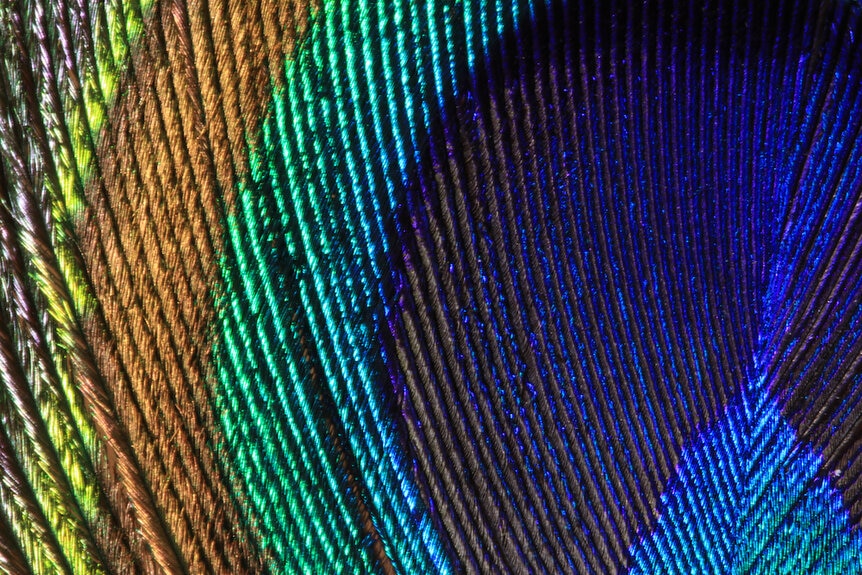Create a free profile to get unlimited access to exclusive videos, sweepstakes, and more!
Showoff birds finally give away secret to their iridescent feathers
Until now, we didn’t know what was behind the flashy iridescent feathers of birds like peacocks.

Humans have been mesmerized by the iridescence of birds for years. Why else would we go from fanning ourselves with peacock feathers to wearing multichrome nail polishes and eyeshadows whose colors shift right before our eyes?
Until now, we didn’t know what was behind these unearthly feathers. Hummingbirds can appear blue at a certain angle and green at another. The level of iridescence in feathers can also vary. Their complex nanostructure is what allows them to literally manipulate light, as researchers from Princeton University found out in a study that merged observations and measurements with evolutionary analysis to find out how such a thing could have evolved.
The pigments used to recreate this effect in makeup and everything else spawned by the multichrome craze are not the same thing that makes some bird species so flashy. Iridescence evolved as different types of melanosomes — structures in cells that synthesize melanin as well as store and move it around — morphed into shapes that could be arranged into thin melanin layers in something of a crystalline nanostructure. How these structures form is still something of a mystery, but what the research team did find was that such thin layers doubled the range of colors which iridescent feathers could potentially shift between. That doesn’t count dinosaur feathers out, either.
"It has now been shown that the crystal-like nanostructures form in the feather filaments after the cells are dead, so a cellular active process is very unlikely," said researcher Klara Nordén, who led a study recently published in Evolutionary Biology. "Instead, we think it forms through a self-organizing process, where melanosomes are attracted to each other."
How this process can create such magical crystals with extreme precision is still unknown, but here is what you can see: If you look at a feather through a macro lens, you will see the barbules, or filaments that branch out within it. The melanosome-based, crystal-like nanostructures that produce iridescence are found in these barbules. If you went further and examined a cross section of that feather under an electron microscope, as the Princeton researchers did, you would see something even more fascinating. Feathers that may look magical have an orderly structure. The melanosomes appear as black dots, rings, or platelets against a gray background of keratin.
The most dazzling birds have both thin and highly complex melanin nanostructures. You see the iridescent special effects when light hits what are known as photonic crystals, which will make light refract, or change its angle, and show changes in the refractive index depending on what is going on with surrounding light. The refractive index refers to the velocity of light going through something to its velocity in a hypothetical vacuum, where it wouldn’t run into anything. Changes in this are the result of certain repeating arrangements of melanosomes in keratin. The size of the layers of melanin and keratin determines the color. Larger layers are needed for a red color than a blue color, since red wavelengths (think infrared) are longer than blue ones.
"It is only when these melanosomes are combined with a multilayer (crystal-like) nanostructure that vibrant colors are produced," said Nordén. "So why did these new types of melanosomes initially evolve in single-layered forms? We speculate that it may be because platelets and hollow forms produce overall brighter colors (also in a single-layer form). Thin rods may facilitate the self-organizing process that helps form layers in the structure."
More opportunities to reflect light also amp feathers with brightness and saturation. The more layers, the more iridescent. But how did melanosomes evolve to have this almost supernatural ability? There are five types of melanosomes, which occur in rod or platelet shapes that can be hollow or solid. Four of these can be found in photonic crystals. The only one that is too clunky for this is the thick solid rod type, which is often found in black or gray feathers and more subtly iridescent feathers of any hue. Thick rods are thought to be an ancestral melanosome that the other four later evolved out of, further evolving to arrange themselves into phonic crystals.
This research could mean that the exact color of fossilized dinosaur feathers (including iridescence) could be figured out just from the structure of their melanosomes. There might have been some really flashy dinosaurs out there. Why iridescence evolved is still unknown. The melanosome structures that cause it have been proven to strengthen feathers and even have antimicrobial properties, but whether they were meant to blend in or stand out remains a mystery. The same thing which mesmerizes the human eye might be an evolutionary side effect. Nordén wants to continue demystifying what makes these feathers so magical.
"I am very interested in is understanding what drives the evolution of iridescent plumage in birds," she said. "Iridescent nanostructures have evolved in many different groups of birds independently, but we don't know much about why. One obvious reason is that birds use iridescent colors for signaling purposes, such as attracting mates with bright colors. But it is possible that there are other drivers of the evolution of iridescence.
What is even cooler about shifty feathers is that their nanostructures could eventually be used to develop next-gen materials that also bend light in a way that is nearly unnatural.



























